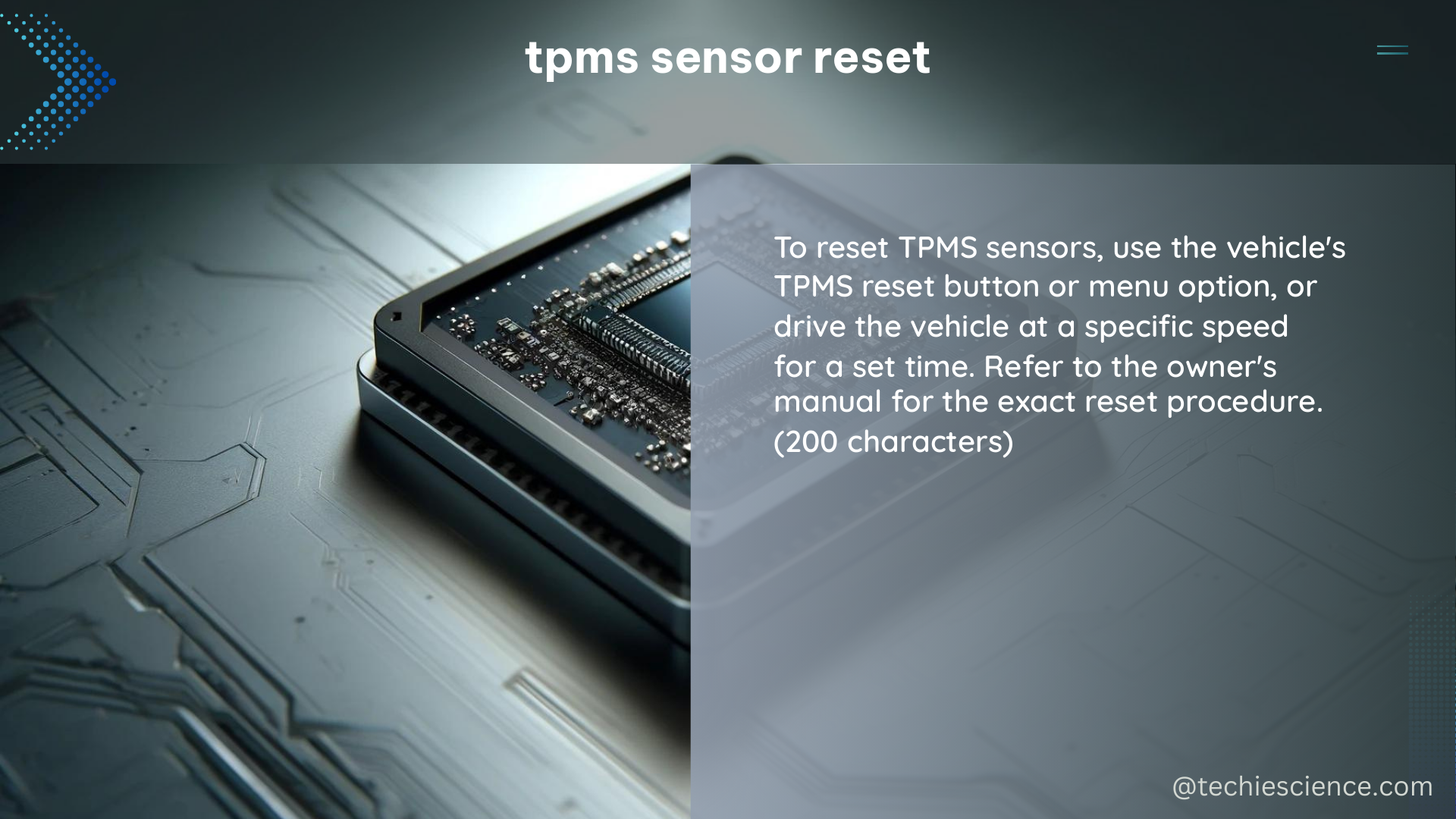TPMS (Tire Pressure Monitoring System) sensors are essential components of modern vehicles that monitor the tire pressure and alert the driver in case of under-inflation. TPMS sensor reset is a crucial process that needs to be performed when replacing or rotating tires or when the battery of the TPMS sensor is replaced. The reset procedure varies depending on the vehicle make and model, and it is essential to follow the manufacturer’s instructions to ensure the proper functioning of the TPMS system.
Understanding TPMS Sensor Specifications
TPMS sensors are designed to operate within specific parameters to ensure accurate and reliable tire pressure monitoring. Let’s dive into the key specifications:
Tire Pressure Measurement Range
TPMS sensors are capable of measuring tire pressure in the range of 0 to 150 psi (pounds per square inch) or 0 to 10.3 bar (kilopascals). This wide range allows the system to detect both under-inflated and over-inflated tires, providing the driver with critical information to maintain optimal tire pressure.
Transmission Frequency
TPMS sensors transmit the tire pressure data to the vehicle’s ECU (Electronic Control Unit) at a frequency of 1 to 4 times per second. This rapid data transmission ensures that the TPMS system can quickly detect and respond to changes in tire pressure, enabling timely alerts to the driver.
Battery Life
The battery life of TPMS sensors varies depending on the type and usage. Most TPMS sensors have a battery life of 5 to 10 years, ensuring long-lasting performance and minimizing the need for frequent battery replacements.
Operating Temperature Range
TPMS sensors are designed to operate within a wide temperature range of -40 to +150°C (-40 to +302°F). This allows the sensors to function reliably in diverse climatic conditions, from extreme cold to scorching heat.
Communication Protocols
TPMS sensors utilize various communication protocols to transmit data to the vehicle’s ECU, including ANTI, ABS, CAN, LF, and H bridge. The specific protocol used depends on the vehicle make and model, and it is essential to ensure compatibility during the TPMS sensor reset process.
TPMS Sensor Reset Procedure

The TPMS sensor reset procedure involves a series of steps to ensure the proper functioning of the TPMS system. Here’s a detailed guide:
-
Turn on the Ignition: Start by turning on the ignition of your vehicle. This will power up the TPMS system and prepare it for the reset process.
-
Locate the TPMS Reset Button: Consult your vehicle’s owner’s manual to identify the location of the TPMS reset button. This button is typically located in the driver’s side footwell, the center console, or the glove compartment.
-
Press and Hold the Reset Button: Once you’ve located the TPMS reset button, press and hold it until the TPMS light on the dashboard blinks three times. This indicates that the reset process has been initiated.
-
Release the Button: After the TPMS light has blinked three times, release the reset button.
-
Wait for the TPMS Light to Turn Off: The TPMS light on the dashboard will remain illuminated for a short period, and then it will turn off. This signifies that the reset process is complete.
-
Drive the Vehicle: To allow the TPMS system to learn and store the reference parameters, drive the vehicle at a speed of 20 to 30 mph (32 to 48 km/h) for 20 to 60 minutes. This driving period is crucial for the TPMS system to calibrate and ensure accurate tire pressure monitoring.
It’s important to note that the TPMS sensor reset procedure may vary slightly depending on the vehicle make and model. Always refer to your vehicle’s owner’s manual or consult with a professional technician to ensure you follow the correct reset steps for your specific vehicle.
Troubleshooting TPMS Sensor Issues
If you encounter any issues during the TPMS sensor reset process or with the TPMS system in general, consider the following troubleshooting steps:
-
Check the TPMS Sensor Battery: If the TPMS light on the dashboard remains illuminated after the reset process, the TPMS sensor battery may be low or depleted. Replace the battery and perform the reset procedure again.
-
Verify TPMS Sensor Compatibility: Ensure that the TPMS sensors installed on your vehicle are compatible with the make, model, and year of your vehicle. Incompatible sensors may cause issues with the reset process or the overall TPMS system performance.
-
Inspect the TPMS Sensor Connections: Check the wiring and connections between the TPMS sensors and the vehicle’s ECU. Loose or damaged connections can interfere with the TPMS system’s ability to receive and process the tire pressure data.
-
Consult a Professional Technician: If you continue to experience issues with the TPMS sensor reset or the TPMS system, it’s recommended to seek the assistance of a professional automotive technician. They can diagnose the problem, provide expert guidance, and perform any necessary repairs or replacements.
By understanding the TPMS sensor specifications and following the correct reset procedure, you can ensure the optimal performance of your vehicle’s tire pressure monitoring system, ultimately enhancing safety and fuel efficiency.
References:
- SMC Systems Engineering Primer & Handbook – AcqNotes
https://www.acqnotes.com/Attachments/SMC%20System%20Engineering%20Handbook.pdf - SUPPLIER HANDBOOK DOCUMENT REVISION HISTORY TRACKER
https://www.hitachi-automotive.us/Supplier/Handbook/Supplier%20Handbook%20Condensed%2010.13.2021.pdf - SMC Systems Engineering Primer & Handbook
https://spacese.spacegrant.org/SEModules/Reference%20Docs/SMC_SE_Primer4-05.pdf - Study on some safety-related aspects of tyre use
https://road-safety.transport.ec.europa.eu/document/download/9327be01-0610-483d-9ef9-8e5e6b8764d6_en?filename=study_tyres_2014.pdf - NDIA IPMD Predictive Measures Guide
https://www.ndia.org/-/media/sites/ndia/divisions/ipmd/ndia-ipmd-predictivemeasuresguide-rev-2-july312017.ashx?la=en

The lambdageeks.com Core SME Team is a group of experienced subject matter experts from diverse scientific and technical fields including Physics, Chemistry, Technology,Electronics & Electrical Engineering, Automotive, Mechanical Engineering. Our team collaborates to create high-quality, well-researched articles on a wide range of science and technology topics for the lambdageeks.com website.
All Our Senior SME are having more than 7 Years of experience in the respective fields . They are either Working Industry Professionals or assocaited With different Universities. Refer Our Authors Page to get to know About our Core SMEs.